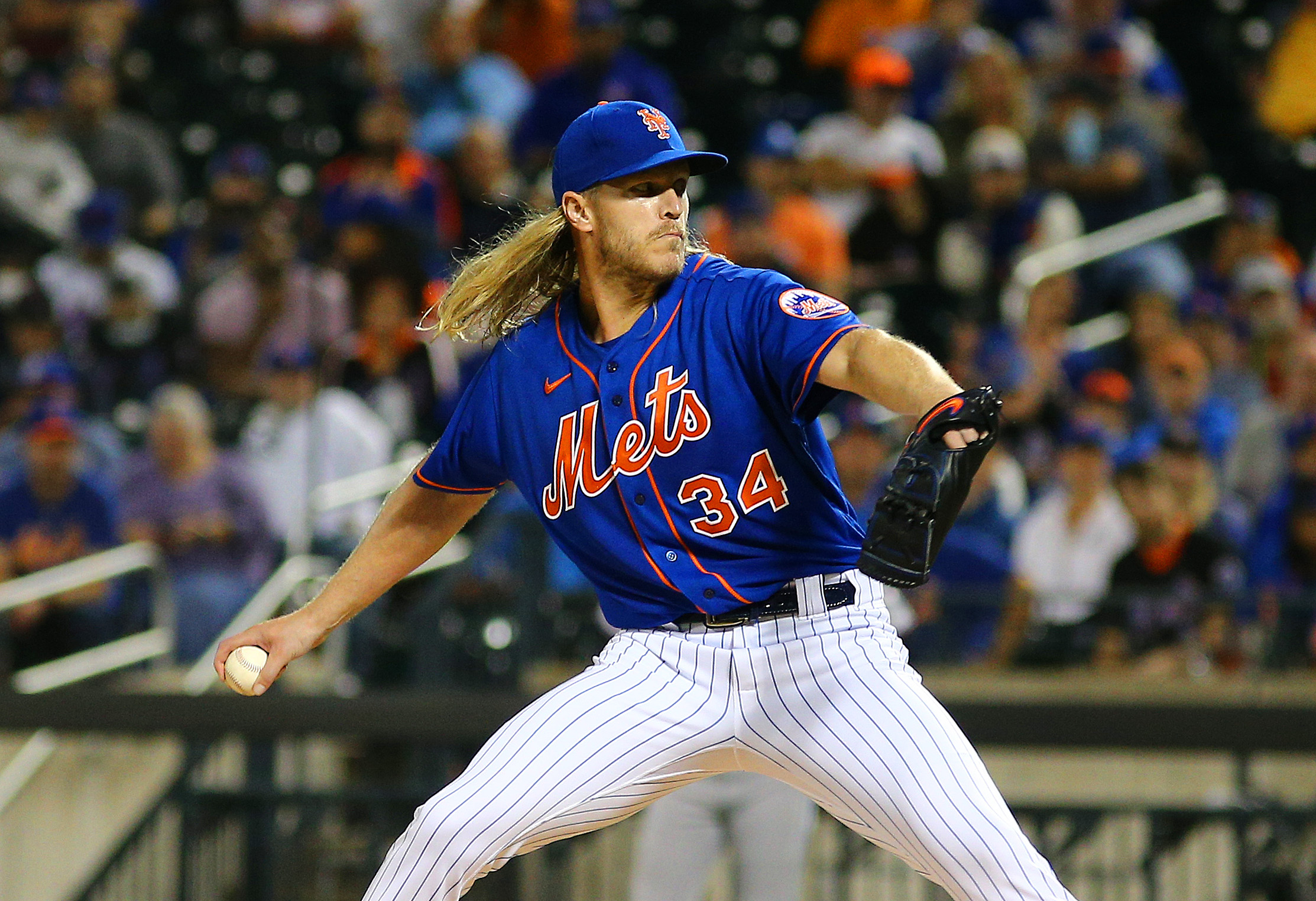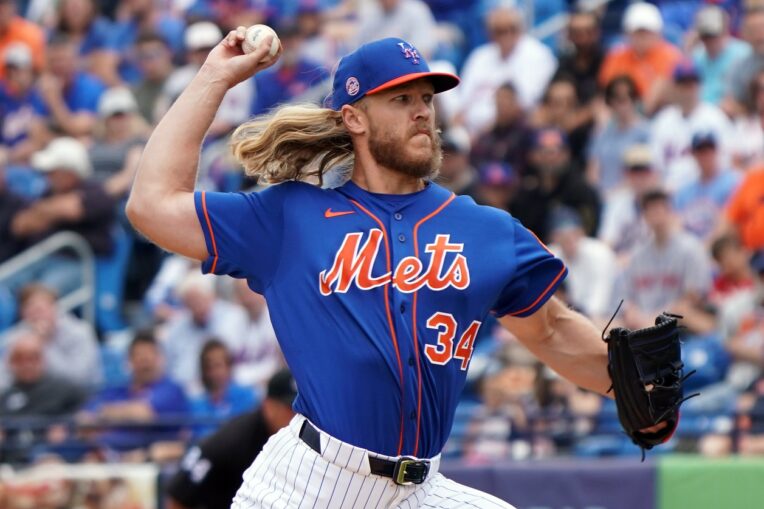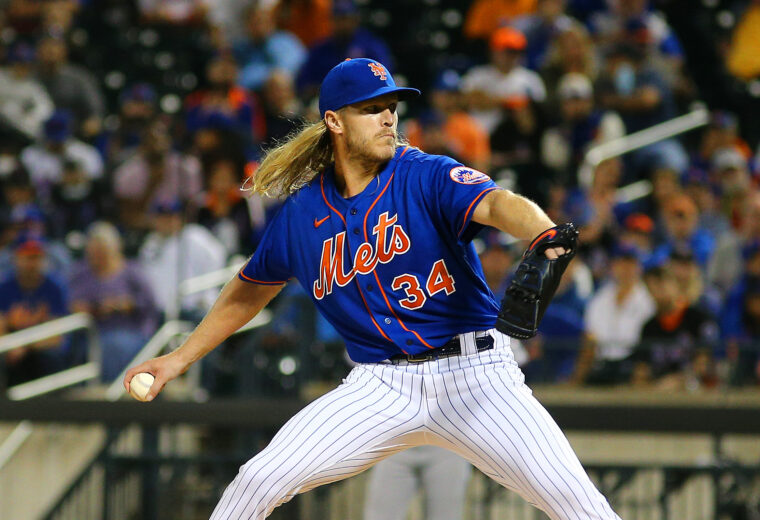
Credit: Andy Marlin-USA TODAY Sports
Following another disappointing end to the regular season, which saw the New York Mets miss the playoffs for a fifth straight year, they’re expected to face some very tough decisions over the offseason, including starter Noah Syndergaard‘s upcoming free-agent status.
After undergoing Tommy John surgery in 2020, Syndergaard spent the first few months of the 2021 season continuing his rehab and was projected to return sometime before the midseason All-Star break, unfortunately, elbow inflammation forced the organization to shut him down for six weeks in May. But due to some lingering concerns, he didn’t return to the mound until late August.
Nearing the end of the regular season, there wasn’t enough time remaining to build the right-hander’s stamina back up, limiting him to a one-inning role through the rest of the schedule. In turn, taking this route allowed him to make his highly-anticipated return to the majors in late September, which saw him make a pair of starts to conclude the campaign.
Over those 2.0 innings of work, the 6’6″ hurler faced eight batters, allowing three hits, two earned runs and one home run while striking out a pair of hitters.
Set to enter his age-29 season in 2022, it’s unclear as to where Syndergaard will call home next season as he’s eligible to become a free agent for the first time in his career this winter. Considering he’s essentially spent the last two seasons – including 2021 – rehabbing from his TJ surgery, his options will likely be limited on the open market.
Assuming any interested suitors don’t overpay to acquire him, which is certainly possible, receiving a one-year deal seems to be the most likely outcome for the former first-round selection. If that indeed proves to be true, then why not stay put in New York through the 2022 campaign?

Credit: Jasen Vinlove-USA TODAY Sports
Syndergaard has already expressed interest in wanting to remain with the Mets, and given his prior success, that feeling should be mutual for the front office as well. While both sides could negotiate a contract extension, the easiest way to solve this issue might be through a qualifying offer – projected to be around $20 million this offseason.
For the Mets in particular, they aren’t projected to feature many potential candidates for the qualifying offer, as both Marcus Stroman (accepted QO last winter) and Javier Baez (traded midseason) are ineligible to receive them. As a result, Michael Conforto and Syndergaard are the only other players who’d warrant this type of offer.
If Conforto ends up declining, which he’s reportedly expected to do, then “Thor” would probably end up being the sole player on the Mets’ roster who’d accept this year’s qualifying offer. Luckily for everyone involved, this move could prove to be very beneficial for both sides.
As currently constructed, this club’s starting rotation is expected to feature Jacob deGrom, Carlos Carrasco and Taijuan Walker. Beyond that trio, things start becoming a little unclear as David Peterson, who suffered a significant oblique strain and also underwent foot surgery, might not be ready to start the season and Tylor Megill is likely better suited to open the year at triple-A Syracuse.
Since Stroman will be aiming to cash in on his current value, which may never be higher than it is right now, a potential bidding war could ensue to acquire his services. With over $112 million already on the books for next season — projected to be eighth-highest in the majors — retaining “Stro-Show” could be time-consuming and might not be wise if his price soars near the $30 million per season range.
Whereas with Syndergaard, there’d be very little doubt about him accepting the qualifying offer, meaning his contractual situation could be resolved fairly quickly, allowing management to focus their attention on other pressing matters.
With the 2016 National League All-Star under contract at a set figure, the Mets would already have one of their two vacant rotation spots accounted for during the early stages of the offseason – that’s no small feat. Then moving forward, the front office could provide its full attention to other key free agents like Conforto and Baez while also making improvements at third base and in the bullpen.

Credit: Steve Mitchell-USA TODAY Sports
For Syndergaard, taking this approach regarding his free-agent status would likely prevent him from being forced to sit idle on the open market while other big-ticket items are prioritized over him. Rather than waiting to sign a one-year, prove-it deal in January or February, he could secure his short-term future long before the calendar shifts to 2022.
Considering the Texas native has been with the same organization for practically his entire career, since being traded from the Toronto Blue Jays during the 2012-13 offseason, there likely isn’t anywhere else he’d rather be ahead of one of the most critical seasons he’s ever faced.
Along with staying healthy, it’ll also be extremely crucial for Syndergaard to prove his TJ surgery hasn’t permanently affected his velocity, which took a dramatic hit over his brief time in the majors this past season.
Granted, the Legacy HS standout barely threw in game action this year, however, it’s still relevant to note that both his four-seamer and sinker averaged in the mid-90s rather than in the high-90s as they had previously in his career. Though once the hard-throwing righty is fully stretched out, the hope is he won’t encounter any further velocity issues.
Even at approximately $20 million, Syndergaard could prove to be a fairly valuable member of the Mets’ roster next season, especially if he returns to his previous dominating form that was on full display prior to his UCL tear.
It may seem like a while ago by now, because well, that’s how time works, but the front-line starter was among the top pitchers in the majors from 2018-2019, where he posted the 11th-highest fWAR rating (8.5) among all qualified starters, according to FanGraphs.com.
Now, no one should immediately be expecting Syndergaard to replicate that same level of production in 2022, particularly because he’s compiled just 10.0 combined innings across four levels of play since 2020. In saying that, there’s no question he still features plenty of upside at this stage of his career, potentially positioning him for a strong bounce-back performance next season.
If that proves to be the case, assuming the rest of New York’s rotation stays healthy, starting pitching would be an area of strength once again for this team, although for a whole six-month stretch this time around.
Whether it’s with the Mets or somewhere else, Syndergaard could reset his value with a solid showing in 2022, likely allowing him to command a multi-year contract around this time next year.
















